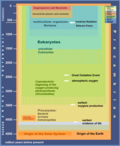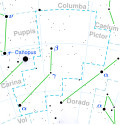Planetesimals (/ˌplænɪˈtɛsɪməlz/) are solid objects thought to exist in protoplanetary disks and debris disks. Believed to have formed in the Solar System...
11 KB (1,163 words) - 15:20, 19 July 2024
Nebular hypothesis (redirect from Planetesimal theory of planetary formation)
possible. The grains eventually may coagulate into kilometer-sized planetesimals. If the disk is massive enough, the runaway accretions begin, resulting...
75 KB (9,132 words) - 11:31, 29 July 2024
The Chamberlin–Moulton planetesimal hypothesis was proposed in 1905 by geologist Thomas Chrowder Chamberlin and astronomer Forest Ray Moulton to describe...
2 KB (342 words) - 11:54, 30 November 2023
Planetary migration (section Planetesimal disk)
or other body in orbit around a star interacts with a disk of gas or planetesimals, resulting in the alteration of its orbital parameters, especially its...
40 KB (5,112 words) - 16:20, 18 July 2024
probably not the source of the Late Heavy Bombardment. According to one planetesimal simulation of the establishment of the planetary system, the outermost...
44 KB (5,482 words) - 15:54, 6 August 2024
these planetesimal encounters shift (migrate) the orbits of the planets by significant amounts. This process continues until the planetesimals interact...
47 KB (5,828 words) - 14:37, 2 August 2024
SDSS J1228+1040 b is a disputed extrasolar planetesimal orbiting the white dwarf SDSS J1228+1040. It was discovered in 2019 using the variable calcium...
5 KB (510 words) - 14:37, 14 July 2024
particles, ranging from centimeters up to meters in diameter, into planetesimals in a protoplanetary disk that is enhanced by aerodynamic drag from the...
22 KB (2,790 words) - 05:44, 14 May 2024
interactions with planetesimals originating in an outer disk drive a slow divergent migration of the giant planets. This planetesimal-driven migration...
103 KB (13,549 words) - 21:21, 16 July 2024
Protoplanet (section The planetesimal hypothesis)
kilometer-sized planetesimals that gravitationally perturb each other's orbits and collide, gradually coalescing into the dominant planets. A planetesimal is an...
24 KB (2,339 words) - 16:48, 18 July 2024
streaming instability is a hypothetical mechanism for the formation of planetesimals in which the drag felt by solid particles orbiting in a gas disk leads...
62 KB (7,642 words) - 18:48, 27 September 2023
The Solar System has unique planetesimal systems, which led the planets to have near-circular orbits. Solar planetesimal systems include the asteroid...
25 KB (2,767 words) - 19:36, 2 July 2024
pancake or ring-shaped accretion disk of matter composed of gas, dust, planetesimals, asteroids, or collision fragments in orbit around a star. Around the...
27 KB (3,397 words) - 18:43, 16 July 2024
planets, and, indeed, a large number of planetesimals formed there. As with the terrestrials, planetesimals in this region later coalesced and formed...
112 KB (13,426 words) - 11:11, 26 July 2024
dust (including primordial nuclides). According to nebular theory, planetesimals formed by accretion, with the primordial Earth being estimated as likely...
218 KB (19,277 words) - 15:44, 6 August 2024
below) Ring system Trans-Neptunian objects Small Solar System body Comets Planetesimal Contact binary Sun Planets Mercury Venus Earth – Moon Mars – moons Jupiter...
29 KB (1,597 words) - 06:46, 3 August 2024
mass to form ever-larger bodies. Local concentrations of mass known as planetesimals form, and these accelerate the accretion process by drawing in additional...
196 KB (20,650 words) - 19:57, 1 August 2024
resonance chain is broken, the five giant planets undergo a period of planetesimal-driven migration, followed by a period of orbital instability with gravitational...
69 KB (8,538 words) - 19:41, 16 July 2024
sailboat changing directions (tacking) as it travels against the wind. The planetesimal disk is truncated at 1.0 AU by Jupiter's migration, limiting the material...
45 KB (5,396 words) - 20:11, 16 July 2024
Beta Pictoris (section Planetesimal belts)
be imaged around another star. In addition to the presence of several planetesimal belts and cometary activity, there are indications that planets have...
58 KB (6,101 words) - 18:22, 16 July 2024
primordial planetesimal disc. While Neptune's orbit was highly eccentric, its mean-motion resonances overlapped and the orbits of the planetesimals evolved...
118 KB (13,220 words) - 04:41, 29 July 2024
Comets Damocloids Meteoroids Minor planets names and meanings moons Planetesimal Planetary orbit-crossing minor planets Mercury Venus Earth Mars Jupiter...
220 KB (21,683 words) - 17:32, 29 July 2024
TRAPPIST (redirect from Transiting Planets and Planetesimals Small Telescope)
The Transiting Planets and Planetesimals Small Telescope (TRAPPIST) is the corporate name for a pair of Belgian optic robotic telescopes. TRAPPIST–South...
8 KB (768 words) - 17:56, 17 May 2024
gravitational encounters between planets, the disruption of an outer planetesimal disk, and the migrations of the outer planets to new orbits. However...
14 KB (1,884 words) - 00:30, 17 July 2024
been further developed using intensive numerical simulations to study planetesimal accumulation. It is now accepted that stars form by the gravitational...
39 KB (4,340 words) - 12:33, 17 July 2024
J.; Bizzarro, M.; Wittig, N.; Connelly, J.; Haack, H. (2005). "Early planetesimal melting from an age of 4.5662 Gyr for differentiated meteorites". Nature...
168 KB (18,644 words) - 15:45, 6 August 2024
Self-gravitational forces are also significant in the formation of planetesimals and indirectly the formation of planets, which is critical to understanding...
9 KB (1,160 words) - 15:29, 1 October 2023
Puna'auia (202773) (541566) Tiki TRAPPIST 1 I40 Transiting Planets and Planetesimals Small Telescope (TRAPPIST); TRAPPIST Cégep de Trois-Rivières Observatory...
354 KB (587 words) - 23:56, 6 August 2024
asteroid belt formed from the primordial solar nebula as a group of planetesimals, the smaller precursors of the protoplanets. However, between Mars and...
82 KB (8,786 words) - 01:36, 6 August 2024
7 Iris is a large main-belt asteroid and possible remnant planetesimal orbiting the Sun between Mars and Jupiter. It is the fourth-brightest object in...
15 KB (1,190 words) - 11:58, 2 August 2024






















